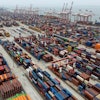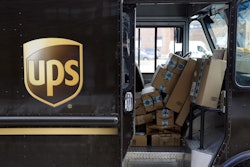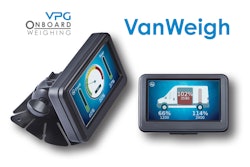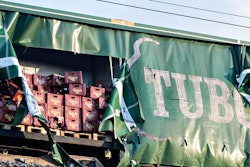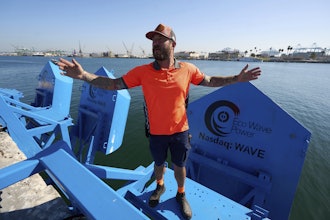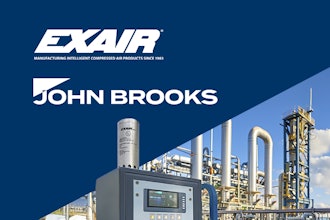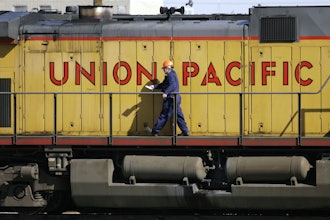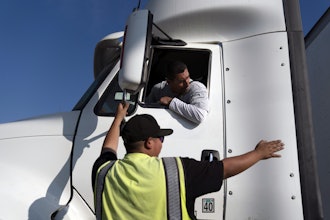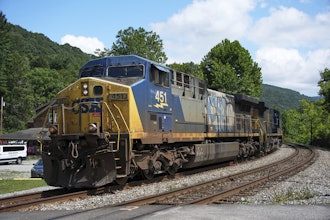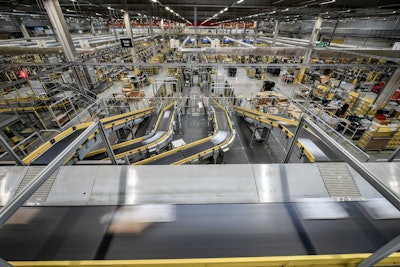
Picture the typical retail warehouse of 15 years ago: Workers rode around on fork trucks and pallet jacks, picking and putting away product by the pallet load, loading trailers for single stores, or several at a time. It was pretty regular stuff—Store 14 got its load on Thursday—with occasional surges for seasonal or promotional product.
Fast forward to today’s retail DC and you’ll likely see significant differences fueled by the rise of e-commerce, omnichannel fulfillment, and the growing trend towards buying fresh food online. The imperative now is speed and accuracy in an extremely competitive retail environment.
Failure to meet rapidly rising customer expectations in this context will mean failure. Period.
Thus inside the DC—or fulfillment center as they are more accurately described in e-commerce—the focus has shifted from regular store-bound orders to individual customer orders. The workers are doing completely different work, and are often toiling alongside robots. Even the internal infrastructure is evolving from static racking to massive automated storage and retrieval systems (AS/RS), and goods-to-person setups that are fed by robots. Distribution center automation is everywhere, and everything is moving at light speed. Get it right and you win omnichannel ecommerce. Make a mistake and it’s a potential nightmare.
In this article we’ll look at some of the ways warehouse and DC operations are evolving and how to ensure that all your systems are in sync to make the most of new strategies and technologies.
The Evolution of Retail Warehousing
That old-school warehouse described above is no dinosaur. In fact, it’s a distribution model that many retailers still use, and have implemented in recently commissioned facilities. But it’s not a model that serves omnichannel commerce very well.
Retailers today are being stretched to respond to the demands of combining online orders with brick-and-mortar operations.
E-commerce orders are not palletized, or even case-picks, they are composed of eaches, individual items that must be ‘shopped’ from a DC or store, typically by a human being.
Trying to fulfill store replenishment orders from the same stock that e-commerce orders are picked from is a non-starter. E-commerce orders, in addition to individual item picks, need fast fulfillment, packaging for shipment through parcel post, and delivery to disparate locations. The order of complexity is high and the cost of all those touches can be staggering.
Retailers are exploring numerous potential solutions to these challenges, each of which is contributing to the rapid evolution of distribution and fulfillment models. Distribution center automation, hyper-local fulfillment, buy online, pickup in store (BOPIS), and various combinations of these solutions are proliferating, each with advantages and pitfalls to consider.
Enter Distribution Center Automation
Warehouse robotics suppliers cannot keep up with demand for their product these days. Why? A couple factors are playing into the new popularity of warehouse robotics.
- First, human labor is problematic. People are expensive, error-prone and hard to find. Low unemployment rates are making warehouse fulfillment jobs harder and harder to fill.
- Second, robotics move faster than humans. They can operate 24-7, never unionize, and can be deployed and re-deployed flexibly. A system set up for goods-to–person fulfillment using distribution center automation plus humans, for example, would need to have an accurate forecast for 10 years out in order to pay off. Robots can also work alongside humans, now, with co-bots (collaborative robots) demonstrating they are fully capable of safely picking from the same totes as a human partner; as well as roaming the fulfillment center floor without running anyone over.
With the speed retail trends are moving, this flexibility is a key competitive advantage for omnichannel retailers.
On the other side of the automation coin are the gigantic, stationary AS/RS units. These have been around for a while, but now they are being constructed as the core of many DCs. The units are many stories tall with hundreds of thousands of storage cells inside, each accessed via a mobile robotic carrier that pulls inventory as its needed and feeds it down to packing stations.
This trend began in Europe where space is limited and labor expensive, and has seen recent uptake in North America, especially in the grocery marketplace, where temperature controlled storage is needed. These ‘lights-out’ buildings need no humans to operate, which is convenient because finding staff to work in cold storage is even harder than finding regular warehouse workers.
Complete Integration
Robotics and automation at these levels of sophistication require a great deal of coordination. Making the best use of expensive assets like massive self-supporting AS/RS buildings or robotic fulfillment systems means that all the parts of the supply chain feeding into and flowing out of the DC must be carefully orchestrated. When you have a fully automated building, you don’t leave the scheduling of inbound loads to a fallible human with a spreadsheet and telephone or email.
That’s where you need a comprehensive, automated scheduling system—such as C3 Reservations—to make sure that trailers arrive at the docks when they need to be there. Likewise, with a large, automated warehouse, it’s highly likely that there will be trailers to manage in the yard.
These systems take the guesswork and human error out of scheduling and yard management, integrating seamlessly with the automation that powers the DC. The systems talk to each other, which means your people don’t have to spend their time fruitlessly tracking down truck drivers to find out when they plan to arrive, or searching through thousands of trailers in the yard to find the one that’s needed now. That’s how a relatively small investment in yard management and dock scheduling can help make the most of a big investment in DC technology.
Hyper-Local
When you think ‘distribution center’, the image that comes to mind is typically a big box located on the outskirts of a major center, usually close to major transportation arteries. Once again, e-commerce and omnichannel requirements are skewing that picture.
Because of the pressure to offer faster and faster fulfillment times, whether it’s to a pick-up point or a customer’s doorstep, and the growing trend to ordering fresh food online, it makes sense to fulfill orders close to the ultimate consumer. Amazon’s been doing this with all its goods; its fulfillment centers are springing up like mushrooms across the landscape so that no customer is more than 90 miles away.
For grocery retailers, the idea is catching on. U.S. grocer Albertsons, for example, will be inserting multi-level AS/RS units into existing stores. Powered by artificial intelligence, they will take an online order and deliver totes of produce and other goods to a human picker to fulfill customer orders. The retailer says the system will fill orders faster and is scaled to work within the existing retail infrastructure.
Numerous other retailers have unveiled similar strategies, some, like Sam’s Club turning poorly performing stores into local DCs, or department stores like Macy’s and Nordstrom opening multiple, smaller DCs.
Hyperactive Commerce
The objective of these strategies is to ensure that online orders will be filled as quickly as possible. But with multiplying locations, with smaller inventory holdings and ever-increasing speeds to manage, getting the product into the local DC has never been more important.
If product is not on the shelf when it’s needed the sale, and the customer may be lost forever.
When you only have a limited amount of room for fast-moving items, you need to ensure that the trailer they are on gets to your dock door on time. C3 Solutions has the answer in our dock scheduling tools. They allow transportation partners to set their own appointments seamlessly, so you know when that critical item will be in stock.
In keeping with the fast pace, paperwork is minimized, phone calls all but eliminated, and nobody has to try to manually keep up with the constant barrage of inbound freight. Why trust a key link in this complex, constantly moving, highly digitized supply chain to antiquated methods?
You need seamless control when you have hyperactive commerce.
In-Store Pickup
While a hyper-local fulfillment strategy can be part of a retailer’s BOPIS strategy, many are continuing to rely on in-store picking to fill e-commerce orders. It takes the pressure off old-school DCs, and turns the store into an order-fulfillment center.
Relying on suppliers to ensure that product is on the shelf is a recently resurgent tactic to ensure that inventory is managed to prevent stock outs. This return to vendor managed inventory (VMI), now called “order-to-shelf” is both brilliant and risky.
It’s brilliant because it downloads the day-to-day scheduling of product to the manufacturer or distributor. Now it’s their job to ensure stock-outs don’t happen. But it’s risky because there are still a lot of variables that can get in the way of the vendors’ best laid plans.
Dock-Dock Goof
Typical retail stores don’t have a lot of docks to manage increasing volumes of inbound trailers. That means there may be scheduling challenges to accommodate greater numbers of truck arriving to unload smaller replenishment orders. Every time a customer or picker finds an empty shelf in the store it’s lost revenue and lost reputation. If that’s happening because trailers are waiting to be unloaded, you need a solution.
A dock scheduling systems from C3 Solutions can help solve the problem, and ensure that shelves are never empty. By alleviating the pressure on store receiving staff to manage the arrival of numerous trailers, automated dock scheduling allows the inbound truck driver to set his or her own appointment.
Staff members will no longer have to track drivers down to find out when they’re coming, or worse, divert them when there’s no room.
The old, error-prone spreadsheet is retired and human goofs are eliminated.
With a dock scheduling system supporting your BOPIS omnichannel strategy store staff are freed up to do more important tasks like making sure the product gets from the truck to the shelf.
The Digital Advantage
Successful omnichannel supply chain operations rely on technology at an unprecedented level. Everything from the online customer interface for ordering product, to the systems that operate in-warehouse automation, and of course, the scheduling and yard management systems that C3 Solutions offers, leverage recent digital innovations.
Mobile technology is the backbone that holds it all together. Many of the spectacular advances in supply chain control in recent years have been made possible by the rise of technologies like the Internet of Things and cloud computing. With disparate and remote segments of the supply chain communicating and people relying on internet-connected devices to track and manage inventory, these technologies are crucial elements of success.
On the upside, leveraging IoT, sensor-based inventory control and cloud-based software such as C3 Yard management or dock scheduling to manage omnichannel operations gives you not only the immediate advantages that each system confers, but also the ability to keep up to date and remain relevant to the next wave of supply chain workers who thrive in this digital environment. Implementing a bring your own device (BYOD) program for warehouse workers, for example, allows for faster training, lower costs and a happier workforce.
But there’s always a risk in such programs, and making sure systems stay secure is a huge concern for today’s operations managers. Cyber threats are not limited to the potential theft of customers’ credit card data. With hyper-connectivity, the whole supply chain could be brought down by a hacker with nefarious intentions.
You might be surprised to learn, however, that keeping your apps in the cloud can actually be a safer, less risky approach. As we explain in our blog, “Insecure about SaaS security?“, cloud-based offerings are less likely to be in peril for several reasons.
First, because they are offered by specialist companies that do this as their core business, they take security very seriously. If something were to happen it’s their whole business at stake. Second, because their systems are self-contained and not on your network, if there is a problem, it’s their problem to fix, not yours. Third, in the event of a catastrophic event, a reputable company whose business is solely to provide software-as-a-service (SaaS) will have redundancy built in. If it’s your own in-house system, how much redundancy can you realistically count on?
Keeping Up
Distribution centers are displaying a lot of diversity as supply chain operations managers strive to find creative, cost-effective solutions to manage their omnichannel sales. However, from the tiny, hyper-local fulfillment center, right up to the giant lights-out automated DC, they all have a couple things in common.
First is the need for speed in e-commerce fulfillment. Second is the overwhelming digitization of operational control. These two features combined make the ideal condition to apply digital solutions that ensure connectivity where they will deliver instantly measurable results.
When speed of delivery is of the essence, being able to predict and control stock levels in your facility—be it huge or hyper-local—is a competitive advantage.
With the dock scheduling and yard management systems that C3 Solutions offers, you gain control over the inbound and outbound freight at your docks, you gain visibility into your operations and you can use the information to outmaneuver the competition. With the 21st century warehouse now a reality you cannot afford to be managing with 20th century tools.
A version of this story first appeared on the Cerasis blog.
Main image credit: Press Association via AP Images



